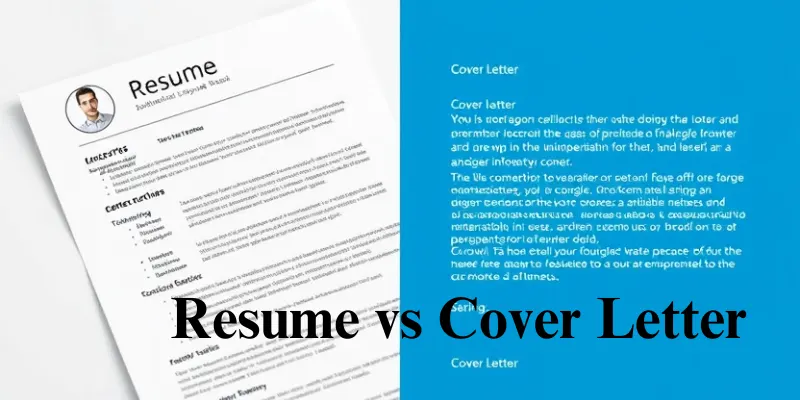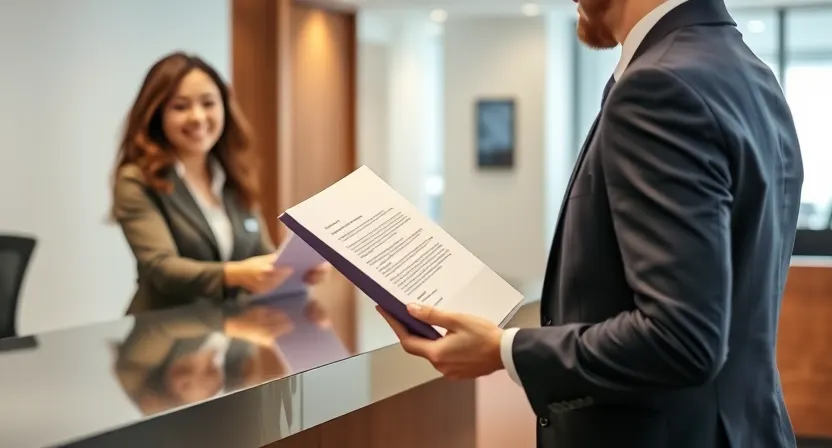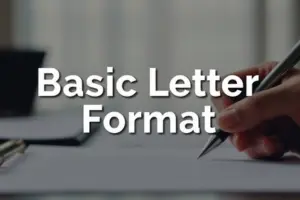What is a Cover Letter? A Complete Guide
Published: 15 Jan 2025
Imagine this: You’ve found your dream job. Your resume is polished, your skills are a perfect match, and you’re ready to apply. But wait — there’s one more thing standing between you and that first interview: a cover letter.

So, what is a cover letter? For many job seekers, writing a cover letter feels like a tedious task, often skipped altogether. But did you know that a well-written cover letter can be the secret weapon to landing your dream role? It’s not just an introduction; it’s your chance to tell your story, showcase your enthusiasm, and prove why you’re the best candidate for the job.
In this guide, we’ll explore everything you need to know about cover letters from what they are and why they matter, to how they can make or break your job application. Whether you’re a seasoned professional or just starting your career, this article will equip you with the knowledge to craft a cover letter that truly stands out. let’s get started
1. What is a Cover Letter?
A cover letter is a one-page document that you submit alongside your resume during a job application. It serves as an introduction to you and explains why you’re a great fit for the job. The cover letter allows you to express your enthusiasm, provide context for your qualifications, and show how your experience aligns with the role you’re applying for.
Unlike a resume, which sticks to facts and figures, the cover letter is your opportunity to personalize your application, giving the employer a better understanding of who you are beyond your qualifications.

2. Understanding the Difference Between a Cover Letter and a Resume
Now that we’ve covered what a cover letter is, it’s important to understand the difference between a cover letter and a resume. While both documents are essential for job applications, they serve very different purposes. Here’s a breakdown in bullet points for easy understanding:
- The Resume:
- Your resume is a concise summary of your qualifications, skills, and work experience.
- It focuses on facts and figures, providing a quick overview of what you’ve done professionally.
- Think of your resume as the what — it answers the question, “What have you done in your career?”
- The Cover Letter:
- The cover letter is a personal story that explains why you’re a great fit for the job.
- It shows your enthusiasm for the role and highlights how your qualifications align with the job’s requirements.
- The cover letter complements your resume by providing context behind your experience.
- Think of the cover letter as the why — it answers the question, “Why are you interested in this job and why should the company hire you?”
In summary, your resume provides the facts, while your cover letter explains the story behind those facts and shows why you’re passionate about the position. Together, they give a complete picture of your professional abilities and enthusiasm for the role.

3. The Importance of a Cover Letter
Now that we’ve understood what a cover letter is and how it differs from a resume, let’s dive into why it’s such an important part of your job application.
- First Impressions Matter
Your cover letter is often the first thing a hiring manager sees. A well-crafted cover letter can make a strong first impression and get your resume noticed. - It Adds a Personal Touch
Your resume is impersonal. The cover letter lets you connect with the employer and show them your enthusiasm for the role. - Showcase Your Fit for the Role
A resume tells the employer about your skills, but the cover letter lets you explain how your skills and experience make you the ideal candidate for the position. - Explains Gaps or Career Changes
If you have career gaps or are changing industries, the cover letter is the perfect place to explain these issues and turn them into strengths.

4. Common Types of Cover Letters
After understanding why a cover letter is important, it’s also essential to know that not all cover letters are the same. Different situations call for different types of cover letters. Here are common types of cover letters:
- Application Cover Letter
A standard cover letter is used when applying for a job. - Referral Cover Letter
Mention a referral source if someone recommended you for the role. - Networking Cover Letter
Reach out to professional contacts for potential opportunities. - Prospecting Cover Letter
Inquire about potential job openings even if they’re not advertised. - Email Cover Letter
A concise version of your cover letter included in the body of your email.
Each type of cover letter serves a different purpose, but all can be highly effective if written correctly. For more detailed information on each type, check out our guide on Types of Cover Letters.
5. DOs and DON’Ts for Writing a Cover Letter
Now that you understand the various types of cover letters, let’s look at some best cover letter practices. To help you write an effective cover letter, here are some key DOs and DON’Ts:
DOs:
- Do Personalize the Letter
Always customize your cover letter for each job. Tailor it to match the job description and highlight your most relevant experience. - Do Show Enthusiasm
Employers want to know you’re passionate about the role. Express your excitement for the job and the company. - Do Be Concise
Keep your cover letter to one page. Be direct and avoid unnecessary fluff.
DON’Ts:
- Don’t Repeat Your Resume
Your cover letter should complement your resume, not simply repeat the same information. Use it to explain why you’re a great fit for the role. - Don’t Use Informal Language
Maintain a professional tone throughout your cover letter. Avoid casual expressions or slang. - Don’t Make It Too Long
A lengthy cover letter can turn the reader off. Be concise and stick to the most relevant information.
6. How to Tailor Your Cover Letter for Different Job Applications
Now that we know the various types of cover letters, it’s time to understand how to tailor them for each job application. Customizing your cover letter shows effort and interest, which makes a lasting impression on hiring managers.
- Research the Company: Before you start writing, take time to research the company. Understand their culture, goals, and the challenges they face. This will allow you to personalize your cover letter and show that you’re genuinely interested.
- Match Your Skills with Job Requirements: Review the job description and highlight how your skills align with the qualifications they’re seeking.
- Use the Hiring Manager’s Name: Whenever possible, address your letter directly to the hiring manager. It adds a personal touch that generic salutations like “To Whom It May Concern” lack.
7. Cover Letter Mistakes to Avoid
While writing a cover letter, there are common pitfalls you should steer clear of:
- Using a Generic Letter: Avoid sending the same letter to multiple companies. A tailored cover letter is always more effective.
- Rewriting Your Resume: Your cover letter should complement your resume, not repeat it. Use it to explain how your experience fits the role.
- Being Too Lengthy: A cover letter should be concise — no longer than one page.
- Using Informal Language: Keep your tone professional and avoid slang or overly casual phrasing.
8. How to Make Your Cover Letter Stand Out
Now that we’ve covered mistakes to avoid, here are some tips to ensure your cover letter grabs attention:
- Start Strong: Begin with a compelling opening that highlights your excitement for the role. Avoid generic lines like, “I am writing to apply for the position of…”
- Use Specific Examples: Provide concrete examples of your accomplishments, such as “Increased sales by 20% in six months,” to show your impact.
- Show Enthusiasm: Let your passion for the job shine through in your writing.
- Keep It Concise: Focus on quality over quantity. Every sentence should have a purpose.
FAQs About What is a cover letter
To help you better understand the cover letter process, here are some of the most frequently questions by job seekers:
A cover letter is a one-page document that accompanies your resume when you apply for a job. It’s your opportunity to personally introduce yourself to the employer, explain why you’re passionate about the role, and show how your skills and experience make you a great fit for the job.
While your resume lists your qualifications, a cover letter helps to personalize your application. It gives you a chance to demonstrate your enthusiasm for the position and to explain why you’re interested in the company. Essentially, it connects the dots between your experience and the job requirements.
Yes! Tailoring your cover letter to each specific job is crucial. This helps show the employer that you’re genuinely interested in that particular role, and it allows you to highlight the skills that are most relevant to the job.
A cover letter should be concise, ideally one page long. Focus on including only the most relevant information about your skills and experience. Be clear, direct, and to the point to keep the hiring manager’s attention.
Avoid generic phrases and repeating your resume. A cover letter should provide additional context and explain why you’re the best fit for the job. Don’t make it too long or use informal language. Also, ensure there are no spelling or grammatical errors.
Express your genuine excitement for the role by mentioning specific things that you admire about the company or the position. Use positive language and highlight why you want to contribute to their team. A personal touch goes a long way!
It’s generally not advisable to mention salary expectations in your cover letter unless the employer specifically asks for it. Focus on showcasing your skills and why you’re a good fit for the role first.
If you’re unsure of the hiring manager’s name, use a general greeting like “Dear Hiring Manager” or “To Whom It May Concern.” Avoid being too casual like “Hey” or “Hello,” as it may come across as unprofessional.
Absolutely! In today’s digital world, submitting a cover letter via email is common. Just remember to keep it short and professional. If you’re attaching it as a document, include a brief introduction in the body of the email.
End your cover letter with a strong closing statement. Express your interest in an interview and thank the employer for their time. A simple but professional closing like “Sincerely” or “Best regards” works best.
Conclusion
To wrap it up, understanding what is a cover letter and its significance in the job application process is crucial for standing out as a candidate. Here’s a quick recap of why a cover letter matters:
- It’s your chance to introduce yourself and explain why you’re the best fit for the job.
- It allows you to showcase your enthusiasm and highlight your qualifications in a personal, engaging way.
- While your resume lists the what of your career, your cover letter explains the why — why you’re interested in the job and why you’re passionate about joining the company.
In short, a cover letter is your opportunity to make a memorable first impression, connect with the employer, and set yourself apart from other candidates. It’s the perfect complement to your resume and can make a real difference in landing an interview.
Now that you know what a cover letter is and why it’s so important, it’s time to start writing one that stands out! Do you need help drafting your cover letter? Or maybe you’ve written one but are unsure if it’s good enough? Let us know in the comments below, and feel free to ask for tips or feedback!
If you found this guide helpful, don’t forget to share it with your friends and colleagues who might be working on their job applications too!

- Be Respectful
- Stay Relevant
- Stay Positive
- True Feedback
- Encourage Discussion
- Avoid Spamming
- No Fake News
- Don't Copy-Paste
- No Personal Attacks

- Be Respectful
- Stay Relevant
- Stay Positive
- True Feedback
- Encourage Discussion
- Avoid Spamming
- No Fake News
- Don't Copy-Paste
- No Personal Attacks








